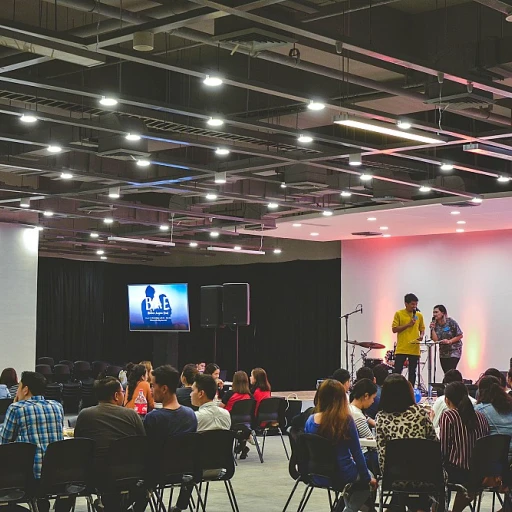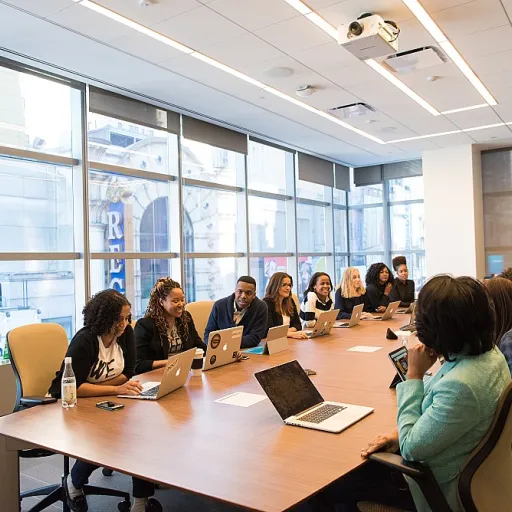
Understanding the Dynamics of a Crowded Workplace
Exploring the Flow of Communication in Packed Workplaces
The modern workplace is a bustling hive of activity, where a constant flow of tasks merges with interpersonal exchanges. This dynamic environment poses unique challenges for effective communication. In a crowded office setting, physical space becomes a valuable commodity. The lack of room not only creates an increased risk of safety hazards but can also stifle both productivity and creativity, making efficient communication an essential part of management.
In these work zones, space is shared among teams and individuals, and creating a balance between collaboration and independent work is crucial. Limited real estate sometimes reduces efficiency as people common areas like meeting rooms and quiet areas can become frequently overbooked. The absence of quiet places for focused tasks can lead to diminished output as employees struggle to find an environment conducive to concentration.
Nevertheless, navigating these challenges successfully requires proactive management strategies. By understanding the dynamics at play in a busy office, leaders can implement practices that help the space work for them, rather than against them. This involves not only optimizing physical areas but also ensuring that communication remains seamless despite the hustle and bustle of the crowded workplace.
For those looking for effective approaches to communication challenges in such crowded environments, consider exploring these effective approaches for frontline communication in human resources.
Common Communication Barriers
Identifying the Obstacles in Communication
In a crowded workplace, communication barriers can significantly impact productivity and team dynamics. Understanding these obstacles is the first step in overcoming them. Here are some common barriers:
- Physical Space Limitations: A busy office often means limited space, which can lead to a lack of privacy and increased noise levels. This environment can make it challenging for employees to find a quiet place to focus or have confidential conversations.
- Constant Flow of Information: In a fast-paced work environment, the constant flow of information can be overwhelming. Employees may struggle to keep up with emails, messages, and meetings, leading to missed communications and reduced efficiency.
- Technology Overload: While technology can facilitate communication, it can also become a barrier when overused. Employees may feel pressured to reply instantly to messages on platforms like Facebook or Twitter, which can distract from more important tasks.
- Safety Concerns: In crowded spaces, safety can become a concern, especially in emergency situations. A lack of clear communication channels can increase the risk of confusion and panic.
- Management Styles: Different management styles can create communication barriers. For instance, a top-down approach may discourage open dialogue, while a more collaborative style might encourage idea sharing.
Addressing these barriers requires a strategic approach. By recognizing these challenges, organizations can implement solutions that will help improve communication and foster a more collaborative environment. For more insights on building strong connections within your team, explore this resource.
Strategies for Effective Communication
Implementing Clear Communication Strategies
In a crowded workplace, where the constant flow of information can be overwhelming, implementing clear communication strategies is essential. The lack of space and increased risk of miscommunication can reduce efficiency and lead to misunderstandings. Here are some strategies that can help:
- Define Clear Channels: Establish specific channels for different types of communication. For example, use emails for formal announcements and instant messaging for quick questions. This helps in managing the flow of information and reduces the clutter in busy office environments.
- Encourage Open Dialogue: Create an environment where team members feel safe to express their ideas and concerns. This can be achieved by promoting a culture of open communication, where feedback is encouraged and valued.
- Utilize Physical Spaces Wisely: Designate quiet areas for focused work and meeting spaces for collaborative discussions. This helps in managing the physical space effectively, ensuring that there is room for both concentration and collaboration.
- Regular Check-ins: Schedule regular meetings to discuss ongoing projects and address any communication barriers. This ensures that everyone is on the same page and can help in identifying any potential issues early on.
- Leverage Technology: Use tools and platforms that facilitate communication, such as video conferencing and project management software. For those looking to enhance their communication setup, exploring top choices for contact center headsets can be beneficial.
By implementing these strategies, management can create a more efficient and harmonious work environment, even in the most crowded workplaces. Remember, the goal is to ensure that everyone has the opportunity to contribute and that communication flows smoothly throughout the organization.
The Role of Technology in Facilitating Communication
Leveraging Technology to Bridge Communication Gaps
In today's crowded workplace, technology plays a pivotal role in overcoming communication barriers. With the constant flow of information and the limited physical space in busy offices, digital tools can significantly enhance the way teams interact and collaborate.
One of the great things about technology is its ability to create virtual spaces where people can communicate without the constraints of physical space. Platforms like Slack and Microsoft Teams allow for real-time messaging, reducing the need for face-to-face meetings that can be challenging to organize in a crowded office. These tools also provide a quiet place for team members to share ideas and reply to messages at their own pace, which is particularly beneficial in a busy work environment.
Video conferencing tools such as Zoom and Google Meet have become indispensable, especially in situations where physical meetings are not feasible. They allow teams to connect from different locations, ensuring that everyone is on the same page, regardless of where they are. This reduces the efficiency loss that often comes with a lack of space for traditional meetings.
Moreover, project management software like Trello and Asana helps in organizing tasks and responsibilities, making it easier for teams to collaborate without the need for constant physical interaction. These tools help in space making by reducing the need for physical storage of documents and files, thus optimizing the use of limited office space.
However, while technology offers numerous benefits, it's essential to ensure that its use does not compromise the safety and security of workplace communication. Implementing robust cybersecurity measures is crucial to protect sensitive information and maintain trust among team members.
In conclusion, integrating technology into the workplace not only addresses the challenges posed by a crowded office but also enhances overall communication efficiency. By embracing digital tools, management can foster a more connected and productive work environment, even in the most crowded spaces.
Promoting a Culture of Open Communication
Fostering Transparent Conversations
Promoting a culture of open communication is essential in any workspace, particularly in crowded workplaces where a lack of transparency can increase frustration and reduce efficiency. Open dialogue will help to bridge gaps and enhance understanding among team members. Encouraging employees to communicate openly and honestly can significantly improve team cohesion.- Organize Regular Meetings: One way to promote open communication is by scheduling regular team meetings. This provides an opportunity for employees to voice concerns and share ideas in a structured environment.
- Create Designated Quiet Areas: Within the limited physical space of a crowded office, providing designated quiet spaces or zones can encourage people to engage in meaningful conversations away from the constant flow of activity.
- Leverage Both Face-to-Face and Digital Platforms: While face-to-face interaction is valuable, combining it with digital communication platforms, such as internal forums or instant messaging tools, can cater to different communication preferences and ensure everyone has a chance to reply and contribute.
- Encourage Feedback: Management should actively seek feedback from employees on whether communication methods need improvement. This can highlight areas where communication could be more effective, supporting a culture of continuous development.
- Offer Communication Training: Conducting training sessions focused on developing communication skills can be beneficial. Providing resources that help employees to navigate conversations in busy offices can enhance team dynamics.
Case Studies and Real-World Examples
Real-World Examples of Effective Communication
In a bustling office environment, communication can often become a challenge due to the constant flow of information and the limited space available for interaction. However, some organizations have successfully navigated these hurdles by implementing strategic communication practices.
Case Study: Tech Company Optimizing Physical Space
A leading tech company faced issues with communication in their crowded workplace. The lack of space was reducing efficiency and increasing the risk of miscommunication. To tackle this, they restructured their office layout into designated work zones. This included creating quiet areas for focused work and open spaces for team meetings. By optimizing their physical space, they improved communication flow and reduced the noise that often accompanies a busy office.
Case Study: Retail Giant Leveraging Technology
Another example is a retail giant that utilized technology to enhance communication among its dispersed teams. With employees spread across various locations, they implemented a digital platform that allowed for seamless communication. This platform enabled instant replies and facilitated the sharing of ideas, ensuring that everyone was on the same page despite the physical distance. The use of technology in this way helped bridge the gap created by limited space and time constraints.
Lessons Learned
These examples highlight the importance of adapting communication strategies to fit the unique dynamics of a crowded workplace. Whether through optimizing physical space or leveraging technology, organizations can overcome communication barriers. By promoting a culture of open communication and ensuring that all team members have access to the necessary tools, companies can create an environment where ideas can flow freely, even in the busiest of offices.












